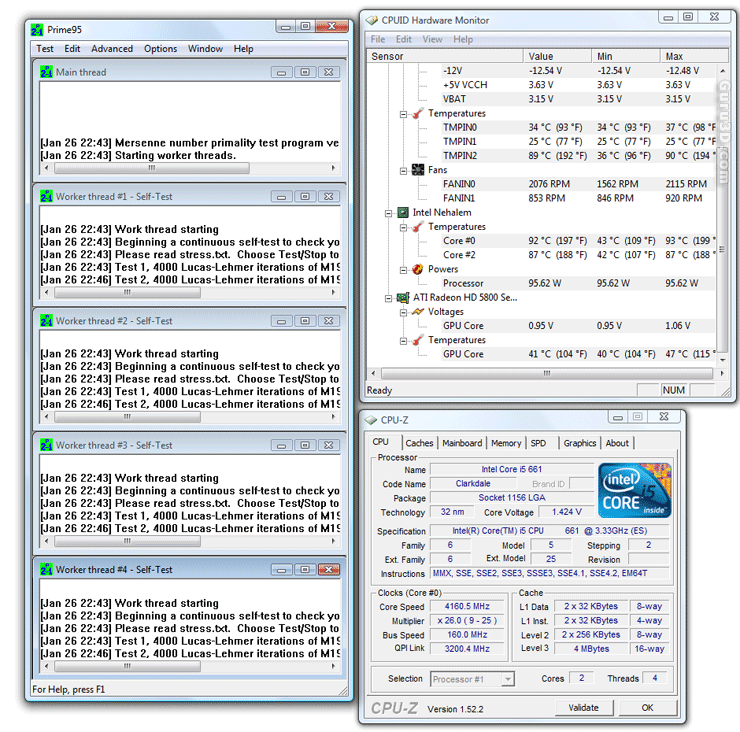Overclocking with the H57-USB3 and Clarkdale
Overclocking with a Clarkdale processor
Okay so first off, overclocking with a reference H55 motherboard was a horrible experience as the BIOS offers no real tweaking options whatsoever. These Intel reference boards are dull. The base clock can be tweaked but there are no voltage, memory, timings or multiplier/divider controls available. And it's okay, the board is just not designed for that kind of use.
The GA-H57-USB3 on the other hand kicks ass pretty well !
Ever since we met the Nehalem family of processors the Front Side Bus was officially annihilated, things tend to change a little in the overclocking department. Only a little though. It's a little weird but the concept remains the same. In the BIOS you'll find a 133 MHz register, labeled the base clock -- look at that as your 'FSB' to play around with. Of course, if you have an Extreme Edition processor, things would be much easier as they have unlocked multipliers; unfortunately this is not the case with the processor we use today.
The processor we used today is multiplier locked, meaning you select the highest possible multiplier and then increase the base clock in the BIOS or Windows tweaking software that comes along with your motherboard.
Just play around with CPU voltage and even on the stock air cooler you can achieve some pretty snazzy results. So we were able to overclock the Core i5 661 processor to 4.2 GHz on the stock Intel air cooler (!). Here's what we did:
- Set maximum processor multiplier (26 for the 660/661)
- Increase processor voltage to 1.40v
- Increase CPU base frequency (we ended at 160 MHz)
- Set QPI ratio as close as possible to 6400
- Lower memory multiplier to maximum stable memory frequency at maximum memory frequency
- At 4.2 GHz on the air cooler we easily boot into Windows. We settled at 25x160 @ 1.4 Volts.
When we stress the CPU cores with Prime 95, temperatures now rose to roughly 93 Degrees C (199F) which was way over the maximum limit you want to go to. Now again, I can't stress this hard enough, this was done with the stock Intel cooler. Proper cooling can get you much higher, with much better temperatures.

Overclocking itself, it is a pretty easy thing to achieve with this processor. Now sure, our tems where completely unacceptable and in fact dangerous. Still, the system remained 100% stable so we ran some numbers. Let's have a look at the overall effect of this tweak.
Gaming - Resident Evil 5
Check it out, same graphics card (5870) and settings as before, 4xAA and all image quality settings set to HIGH. The overclock towards 4.2 GHz brings in much more performance top Resident Evil (if you pair it with a high-end graphics card).
At 1920x1200 the 4.2 GHz processor even passes an X58 platform with Core i7 965 (3.2 GHz), which definitely gave me a laugh. An expensive laugh though as these puppies cost me 999 USD.
Video Transcoding
I have another overclocking example to show you. Transcoding video's again. A dual-core processor in this test has no chance to a quad-core really, but overclocked you will make quite a large jump. That's not bad really !
Mind you that overclocking will draw more power from your system, let's have a look at that.
Overclocking and power consumption
Okay, check this out then:
| Product combo |
idle |
100% CPU |
| GA-H57M / i5 661 + 5870 |
78 |
133 |
| GA-H57M / i5 661 + 5870 @ 4.2 GHz |
89 |
180 |
What a lot of you do not realize is that overclocking a processor will consume more Wattage. We put this to the test by monitoring power consumption with the processor at its default settings and then overclocked to 4.2 GHz.
When we stress the 2 (4 threads) CPU cores 100% at default (non-overclocked) we peak at roughly 133 Watts. Once we overclock to 4.2 GHz the power consumption all of a sudden is 180 Watts and thus is costing us an additional 47 Watts. Definitely something to think about before you start to overclock, but by far not as bad as overclocking the quad-cores TBH.
